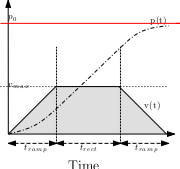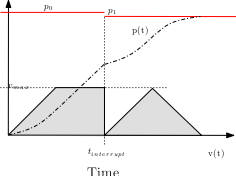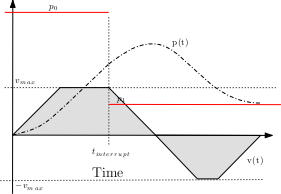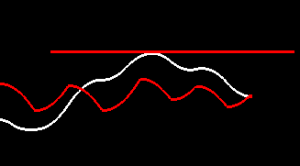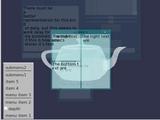We were recently working with the WAM robot and needed to generate trajectories from a haptic device. The WAM code-base had code for following a simple trapezoidal trajectory. It is straightforward to generate such a trajectory given
maximum velocity and acceleration constraints.
The WAM library routines allowed to issue more positional commands (using MoveWAM), but the previous trajectory would be halted and the new one started with an initial velocity of zero. The figure below illustrates what would happen:
Clearly the p(t) curve is not smooth at the time of the new interruption (v(t) is discontinuous); this is evident in the robot motion. A worse case occurs when the commands are issued more frequently, implying that the trajectory can never reach
full velocity.
Instead of creating a new trajectory with zero velocity, especially when the subsequent commands are the same as the previous command, the trajectory should take into account the current velocity. So instead of the result above, the interruption should still
produce a curve more like that in the first figure. Regardless of where the interrupted commadn is received (or its location), the resulting positional trajectory should obey the constriants. For example:
The implementation is straightfoward. There are main two cases to handle. Like before, if the distance to travel is large, the trajectory will have a period owhere the velocity is at maximum velocity. The details of the implementation are in the attached document (trapezoid-writeup)
Results
The figures below illustrate what the curves look like (red always starts at zero velocity, and white utilize current velocity).
The bottom figure illustrates the non-smoothness of the trajectories that would be generated if the current velocity is ignored.
Video
trap.mov
See it in action here: IROS_predisp
Python Code
A quick python prototype was used to validate the first step. Click on the window at the y-location you want the curve to go to. Currently the implementation actually uses the velocity profile and needs to integrate (uses simple Euler method to do so). Alternatively, you could easily store the positional curve and just look up the position.
rob.py
